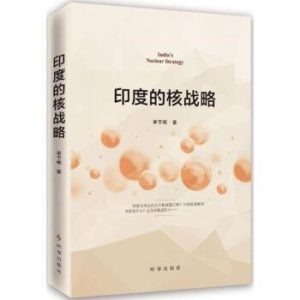
Zhang Jiegen 章节根
Current Affairs Press (China) 时事出版社, 2015.
Reviewed by Han Wei (Fudan University; HYI South Asian Studies in China Program, Visiting Fellow, 2019-20)
India’s Nuclear Strategy, written by professor Jiegen Zhang, was adapted from the author’s Ph.D. dissertation with the same title. The book is the first systematic study to delve into the contents and origins of India’s nuclear strategy from both a domestic and international perspective within Chinese academia. The book tries to answer the following core research questions: What has driven India to a path of public nuclear deterrence? What are the features and content of India’s nuclear strategy? How will India’s nuclear strategy influence international security? The book is divided into six chapters in order to answer the above questions.
The first chapter describes the history and framework of India’s nuclear strategy. India’s defense scientists, military strategists and political leaders altogether produced their nuclear strategy, which pursues recessed deterrence and credible minimum deterrence. The author discusses the domestic and international factors that have shaped India’s nuclear strategy respectively in the second and third chapter. From the perspective of the author, India’s strategic culture that focuses on the South Asian subcontinent, lacks a unified grand strategy, emphasizes defense, sticks to independence and nonalignment, and neglects military force in strategic decision-making, are the major elements of India’s nuclear strategy. On the international side, the existing global nuclear power system and regional security threats have influenced the development of India’s nuclear strategy.
The fourth chapter analyzes India’s two nuclear doctrines, namely No First Use and Credible Minimum Deterrence. The author argues that a No First Use nuclear doctrine is ambiguous in the situations in which India would use nuclear weapons and that this doctrine could be a political deception and might change in accordance with India’s national interests. The Credible Minimum Deterrence doctrine, however, contains an inherent contradiction between “the most credible” and “the minimum”, which could cause the international credibility of India’s nuclear doctrine to fluctuate. The fifth part introduces the development of India’s nuclear power and the last chapter concludes with the influence of India’s nuclear strategy in the context of Sino-India relations.
The book is overall a comprehensive study that examines the origins, contents and influence of India’s nuclear strategy, offering Chinese readers a convenient means to access and understand the basic facts of the issue. Not only does the work theoretically review some important concepts related to the topic like “strategy”, “nuclear doctrine” and “strategic culture”, but it also provides a window into the practice of India’s nuclear strategy, at a time when the majority of Chinese academia’s attention and research remains centered on the nuclear issues of the US.
However, the book should have included more aspects into its analysis in order to match its broad theme as the book’s title indicates. First, it has a large scope but provides a less than persuasive analysis. For example, when analyzing the domestic and international factors that have shaped India’s nuclear strategy, the book does not provide persuasive and comprehensive analysis, while only ascribing the domestic motivation to strategic culture and the international effects to the global system and regional threats. Second, the author should have added more weight to the book’s concluding part which describes the influence of India’s nuclear strategy. The last part, ideally, should be more comprehensive and rational in order to better examine any such influence from different aspects.
Although in certain areas the book lacks some details and a more persuasive analysis, the author still systematically introduces India’s nuclear strategy, which helps the Chinese audience to better understand India.
